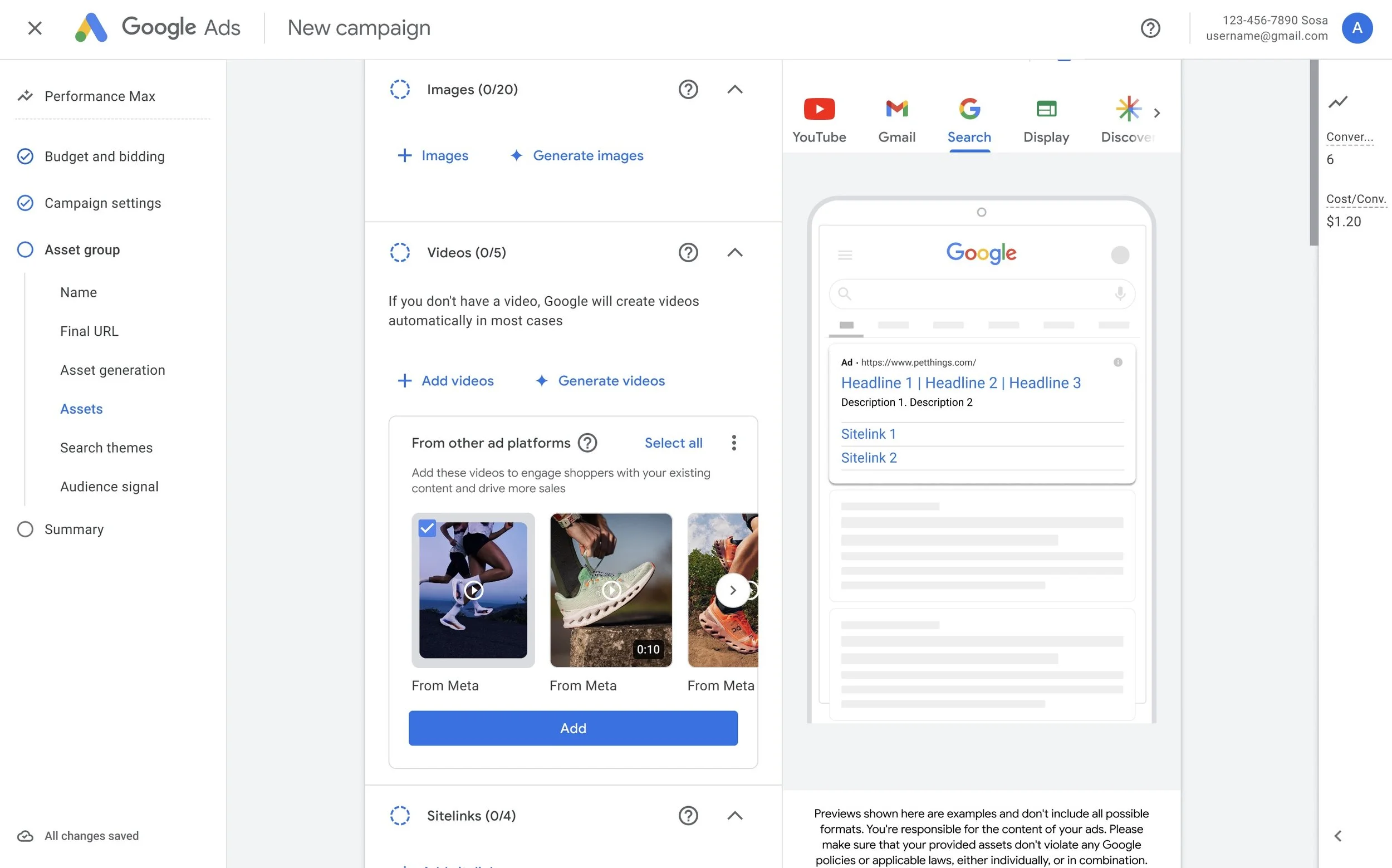External Creative Onboarding
Discovery & Concept Testing
Overview
Discovery & Concept Testing to evaluate advertiser adoption of importing external video creatives (e.g., Meta) into Google Ads. This case study spotlights my process, decisions, and impact.
Due to confidentiality, specific insight statements, quotes and full interactive prototypes and screen designs are omitted; I’m happy to walk you through them live.
Challenge
Advertisers already make vertical, engagement-first video for social platforms but rarely reuse those assets in Google Ads. Without easy reuse, video adoption in Performance Max and Demand Gen lags, leaving Shorts and Discover under-monetized.
Business Challenge
By 2024, torso merchants were sending nearly 70% of their upper-funnel budgets to Meta and TikTok, leaving Google with just 30%. Advertisers viewed Google as a demand capture platform with prospecting CPAs ~3x higher than Meta, while social platforms were seen as engines for demand creation.
At the same time, most weren’t reusing their social video in Google Ads; 90–95% of assets were uploaded during campaign construction, yet friction, legal uncertainty, and reformatting costs kept video from flowing into PMax and Demand Gen.
This left Google with under-monetized inventory in YouTube Shorts and Discover, threatening 2025 revenue targets unless creative onboarding became seamless.
Product Challenge
The proposed feature—importing external video into Google Ads—needed to strike a balance. Advertisers wanted speed and convenience, but not at the cost of trust, ownership clarity, or brand safety. Product decisions around preview, consent placement, and storage options had to be prioritized for MVP, while bulk import, transparency, and auto-policy checks would sit in backlog.
The challenge was reducing friction without overpromising, and building a flow advertisers would actually trust.
Research Challenge
Our task was to validate whether advertisers truly understood and valued the conceptbeyond surface appeal. We had to uncover where trust broke down, where usability created friction, and which signals would drive adoption. The challenge wasn’t just gathering opinions; it was converting early feedback into a clear sequence of product decisions that leadership could use to scope, prioritize, and de-risk the launch.
Participants
11 torso merchants (mix of direct advertisers and agencies) actively running Google Ads and social video.
Selected for: hands-on campaign building, recent PMax/Demand Gen activity, and regular Meta video usage ensuring evaluations of import workflows reflected real-world constraints and goals.
Process
I led the research end-to-end from framing objectives to final readout.
Translated revenue OKRs into researchable questions around trust, friction, and adoption.
Designed and executed remote, semi-structured concept testing interviews (n=16) with torso merchants active on both Meta and Google Ads.
Probed reactions to the value prop, preview, ownership confirmation, and storage flows.
Applied rigor controls (piloting, neutral prompts, traceability matrix, decision log).
Facilitated a synthesis workshop with PM, Design, Eng, and Legal to drive product alignment.
My Role
Translated revenue OKRs into researchable objectives and success criteria.
Owned study design (screener, guide, stimuli), pilot, moderation, and data handling.
Led synthesis and decision workshops; maintained a traceability matrix and decision log.
Aligned PM, Design, Eng, and Legal on MVP vs. backlog trade-offs and risks.
Research Process
Frame & Align — Defined objectives around comprehension, trust, and friction; mapped each to probes and success signals.
Design — Remote, semi-structured interviews (60 min) with prototype walkthroughs to balance discovery depth with task realism.
Recruit — Targeted advertisers with active Meta+Google workflows to test real import behaviors.
Pilot & Iterate — Refined prompts, counter-ordered tasks, removed leading language; adjusted stimuli for clarity.
Moderate — Probed value prop, preview needs, ownership confirmation, and storage options; captured disconfirming evidence.
Synthesize — Built a theme model with confidence ratings; converted signals into product decisions via a facilitated cross-functional workshop.
Business Impact
Positioned Google to recapture top-of-funnel budgets by reducing friction for advertisers to reuse existing social video creatives.
Increased readiness to monetize Shorts and Discover inventory.
Reframed adoption drivers for leadership: trust > convenience in early MVP scoping.
Product Impact
Design changes: clarified value-prop copy and source labels; repositioned consent later in the flow; added video preview before Final URL.
Roadmap: preview and draft upload prioritized for MVP; multi-select import, transparency on enhancements, and auto-policy checks logged for backlog.
Decision hygiene: traceability matrix linked objectives → probes → signals → decisions, enabling accountable trade-offs.
Cross-team Alignment
Partnered with Design to probe consent/hosting flows.
Worked with Eng on feasibility of preview, bulk import, and draft upload.
Collaborated with Legal/Policy on ownership copy and source transparency.
Facilitated a synthesis workshop that sequenced MVP vs. backlog and clarified risks, owners, and next steps.
Executive Clarity
Delivered an evidence-based narrative directly linking research signals to revenue risk, product scope, and launch readiness.
Produced a single-page roll-up (Problem → Method → Impact) and maintained a decisions log for accountability.
Reflections
Rigor: Objectives mapped to decisions; pilot iteration and bias controls documented; confidence levels stated.
Ownership: Led end-to-end—from scoping and moderation to synthesis and executive readout.
Collaboration: Structured workshops drove alignment across PM, Design, Eng, and Legal.
Deep thinking: Balanced advertiser trust with near-term revenue goals; recommended an MVP that builds confidence first, then scales convenience.
Due to confidentiality, detailed advertiser insights are not shown here, but I’d be glad to walk you through them live.
